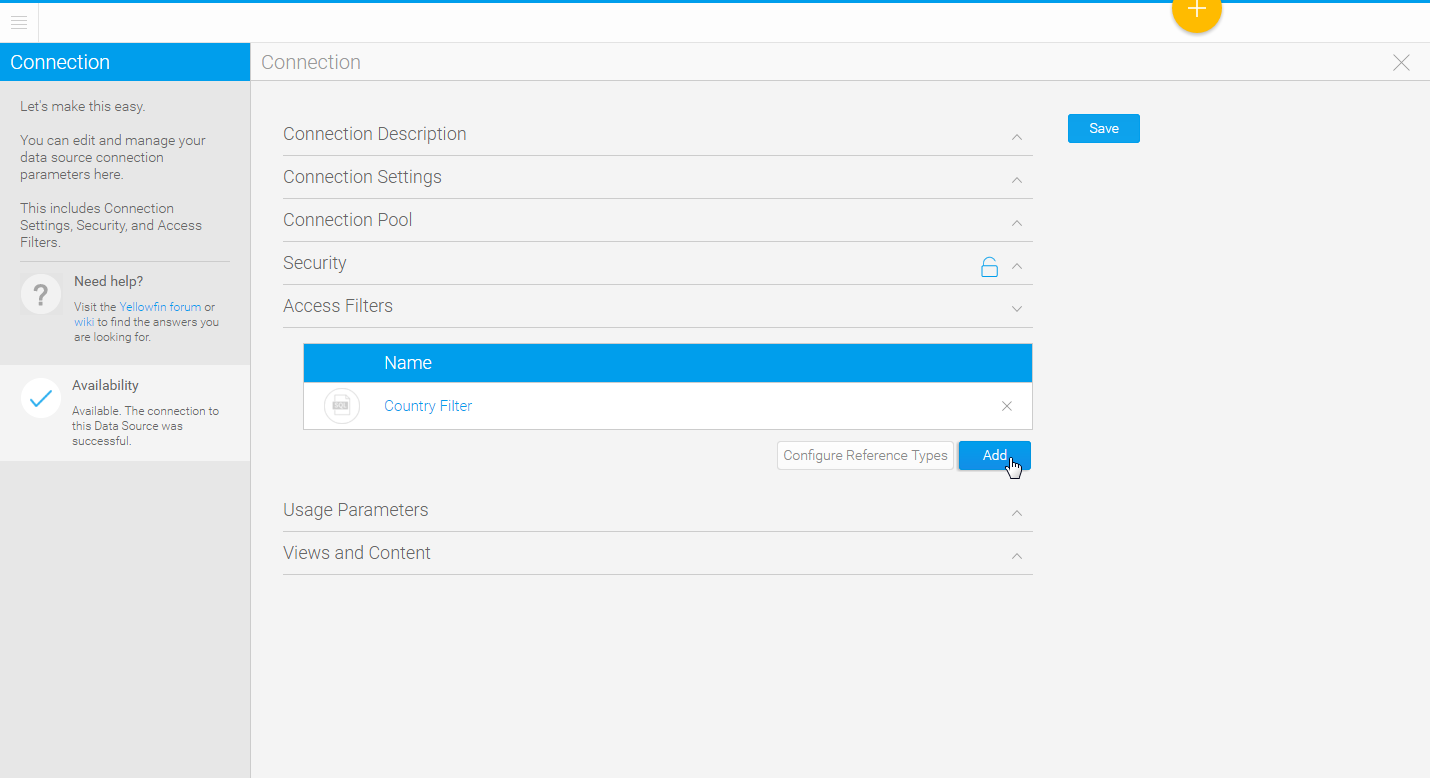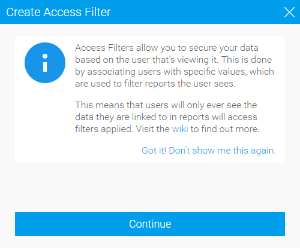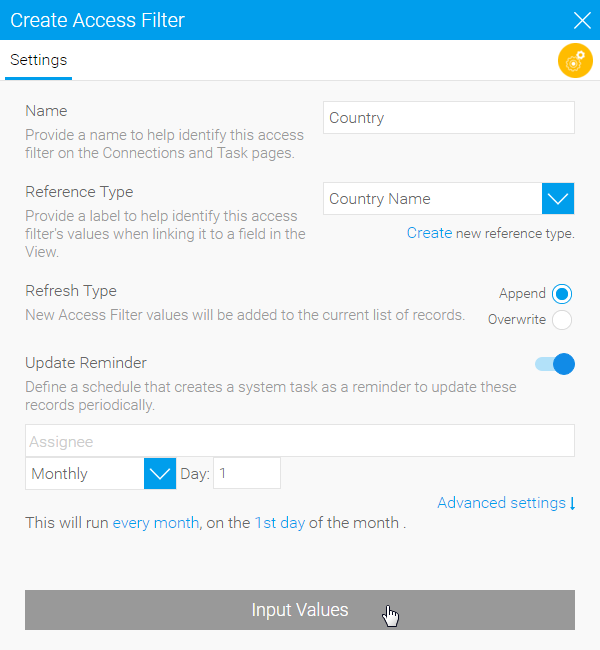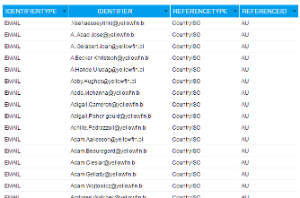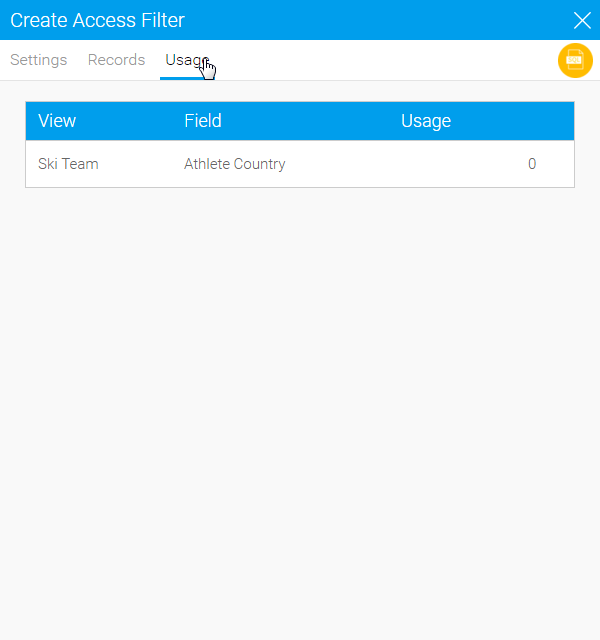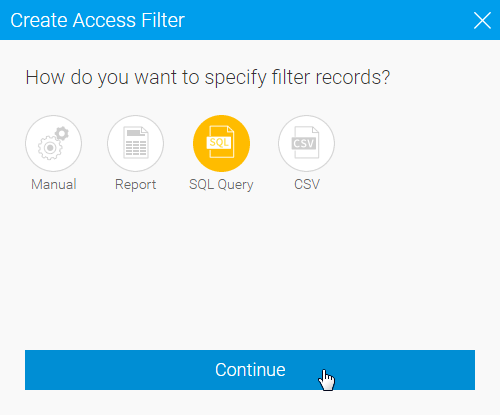Page History
| Table of Contents | ||
|---|---|---|
|
Overview
| Styleclass | ||
|---|---|---|
| ||
| top |
The steps for setting up Access Filters are:
- Create an Access Filter on the data source
- Assign the Access Filter to a field on a view
- Define a default Access Filter on the view
- Assign an Access Filter to a report
Configure Reference Types
Each source filter that you create needs to be categorised by a reference type. This is used to link the data in your source system with Yellowfin meta-data. It also provides a way to categorise the type of filters that you can make available for your views.
Filter Parameters
Each Access Filter contains a list of one or more records matching a Yellowfin user to a Reference Id. These can be loaded into the system in three ways: manual entry, from a CSV file, or by running a scheduled query on the source database.
In each case you will need to enter records consisting of four fields (in this order):
| Identifier Type | Identifier | Filter Type | Reference ID |
|---|---|---|---|
The Identifier Type and Identifier are used to identify a Yellowfin user. The Identifier Type can be either
The user id related to the user id used within Yellowfin. | The Identifier field will then be the corresponding user id. | The Filter Type field is used to determine what type of filter this is. This is critical to assist users when creating views or reports. Select a user friendly type name. | The Reference Id field is the corresponding data for the matching user. |
Settings
Complete the settings step in order to define how the access filter records will be sourced and updated.
| Setting | Description |
|---|---|
| Name | Provide a name to help identify this access filter on the Connections and Task pages. |
| Reference Type | Provide a label to help identify this access filter's values when linking it to a field in the view. See the Configure Reference Types section for more information. |
| Refresh Type | You will have two refresh options:
|
| Update Reminder | Define a schedule that creates a system task as a reminder to update these records periodically. |
User
Search for the user you wish to assign a value to, selecting their name from the list.
Value
You will now be able to define the value to be associated with each user. You can only have one value per row, so if you want a user to have multiple values you will need to add their name multiple times.
Records
You will now be able to view all the records loaded into your Access Filter.
Usage
You will be able to see a usage count to help identify how and when your Access Filter is used.
Settings
Complete the settings step in order to define how the access filter records will be sourced and updated.
| Setting | Description |
|---|---|
| Name | Provide a name to help identify this access filter on the Connections and Task pages. |
| Select a Report | Select a report that has been enabled as an access filter source. |
| Refresh Type
| You will have two refresh options:
|
| Refresh Schedule | Define whether access filter records will automatically be updated based on a schedule. |
Report
In order to select a report to use for access filter records, you will have to have a report saved with this setting enabled.
The report may look something like this:
Records
You will now be able to view all the records loaded into your Access Filter.
Usage
You will be able to see a usage count to help identify how and when your Access Filter is used.
Settings
Complete the settings step in order to define how the access filter records will be sourced and updated.
| Setting | Description |
|---|---|
| Name | Provide a name to help identify this access filter on the Connections and Task pages. |
| Data Source | Select a source that will be queried to return access filter records. |
| New User Auto Refresh | Define whether the access filter records need to be automatically refreshed every time a new user is created. |
| SQL Query | Define the query used to return access filter values, in the format outlined in the Filter Parameters section. |
Once the SQL has been defined, it will need to be validated. Click the Validate button and you will either be shown errors returned from the database, or this valid message.
| Setting | Description |
|---|---|
| Refresh Type | You will have two refresh options:
|
| Refresh Schedule | Define whether access filter records will automatically be updated based on a schedule. |
Once complete, use the Submit button to save your access filter and load values.
Records
You will now be able to view all the records loaded into your Access Filter.
Usage
You will be able to see a usage count to help identify how and when your Access Filter is used.
CSV Access Filters
| Styleclass | ||
|---|---|---|
| ||
Settings
Complete the settings step in order to define how the access filter records will be sourced and updated.
| Setting | Description |
|---|---|
| Name | Provide a name to help identify this access filter on the Connections and Task pages. |
| File | Upload a csv file to provide values for the access filter records, in the format outlined in the Filter Parameters section |
| Refresh Type
| You will have two refresh options:
|
| Update Reminder | Define a schedule that creates a system task as a reminder to update these records periodically. |
Records
You will now be able to view all the records loaded into your Access Filter.
Usage
You will be able to see a usage count to help identify how and when your Access Filter is used.
Assign to a View
| Styleclass | ||
|---|---|---|
| ||
- Create your view as normal, and then on the Fields page, select a field that corresponds to one of the Reference Types you have created.
- On the Access tab, select the correct type from the Access Filter selection. You will not be able to select Reference Types that don’t have any filter records saved against them.
- Once you have selected the Access Filter, save the field. You can select more than one field to be different Access Filter types if you wish.
- Once you have finished assigning access filter types to the fields on the view, go to the View Security page. You can select a default filter to be applied to reports created against this view here, or choose not to have one. If you select a default filter, any subsequent report created against this view will have the filter applied. Users creating reports that have the appropriate access level can change or remove the filter on a per-report basis.
Assign to a Report
| Styleclass | ||
|---|---|---|
| ||
On the Report Data page, open the Report Data section in the Report Options box on the right hand side. The Access Filter selection box contains any filters that have been attached to the selected view.
If you select a filter, it will be applied to the results for each user when they run the report.
Note: that only users with the appropriate security access level will be able to change the Access Filter on a report.
| horizontalrule |
|---|
| Styleclass | ||
|---|---|---|
| ||


